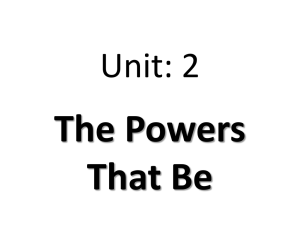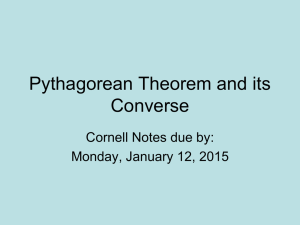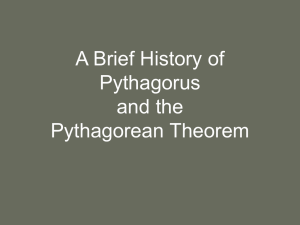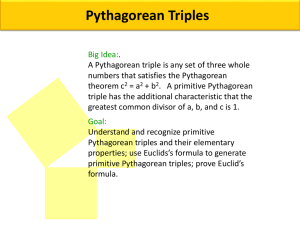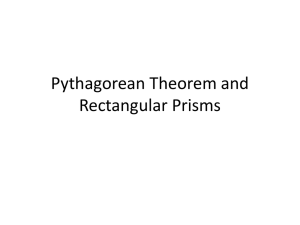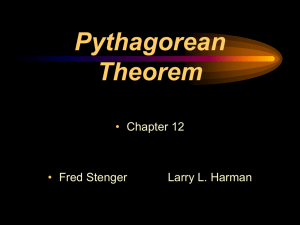13 Salazar Project
advertisement
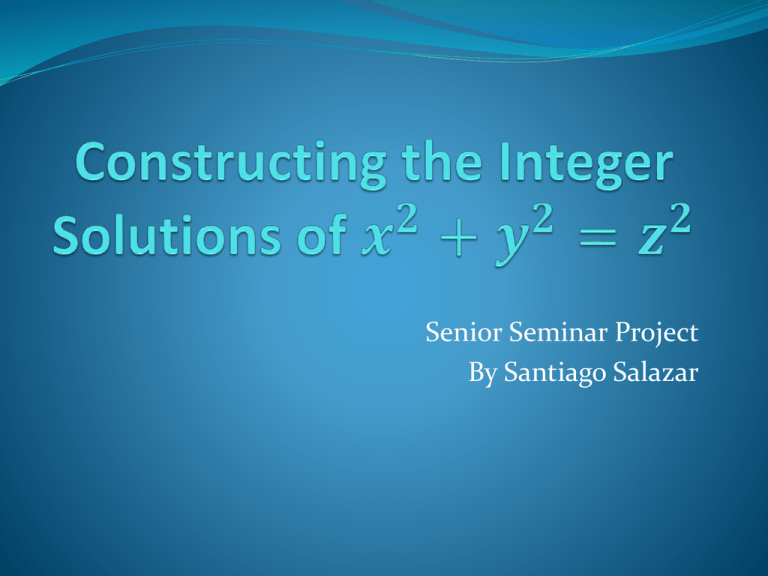
Senior Seminar Project By Santiago Salazar Pythagorean Theorem In a right-angled triangle, the square of the hypotenuse is equal to the sum of the squares of the legs. The Pythagorean Proposition by Elisha S. Loomis (1852 - 1940) A compilation of proofs to the Pythagorean Theorem It contains more than 367 distinct demonstrations The proofs were classified into four categories No trigonometric proofs since the whole body of trigonometry depends on the Pythagorean Theorem, and in particular, on the relationship sin2 𝜃 + cos 2 𝜃 = 1, which is derived from it Loomis clarifies that a trigonometric proof constitutes circular reasoning and is therefore incorrect Four kinds of Demonstrations Those based upon linear relations –the algebraic proofs Those based upon comparison of areas –the geometric proofs Those based upon vector operations –the quaternionic proofs Those based upon mass and velocity –the dynamic proofs Pythagoras (ca. 575-495 BCE) Born on the Island Samos, off the coast of modern-day Turkey There is no reliable information about him Traveled through Egypt and Mesopotamia, where he probably increased his knowledge of Mathematics, Philosophy, and Religion Also traveled to Miletus, where he made advances in geometry under philosophers and mathematicians such as Thales of Miletus, Anaximander, and Anaximenes Pythagoras (ca. 575-495 BCE) Moved to Croton (today, Crotone in southern Italy), about 530 BCE There he founded a society, denominated the Pythagoreans, whose main interests were religion, mathematics, astronomy, and music The nature of the universe could be explained by numbers and their ratios Egypt During his trips to Egypt, Pythagoras probably came in contact with the measuring method of the Harpedonapts (rope stretchers) Egyptian used, for architectural purposes, ropes tied with 12 equidistant nodes to create right triangles of lengths 3,4, and 5 units This suggests that the Egyptians had some insights about the special case of the 3-4-5 right triangle well before Pythagoras proved the more general version Harpedonapts (Rope strechers) Mesopotamia (Babylonians) Babylonians had some insights about this theorem ca. 1800 BCE This shows the high level of mathematical knowledge that existed well before the Greeks They discovered a significant number of Pythagorean triples They solved problems that could only be solved with the use of the Pythagorean triples and the Theorem of Pythagoras Plimpton 322 (ca. 1800 BCE) Plimpton 322 (ca. 1800 BCE) A Babylonian clay table containing Pythagorean triples G.A. Plimpton Collection at Columbia University One column is missing, which is believed to contain the third number in each Pythagorean triple 15 rows and 4 columns India and China About 800 BCE in India, ancient mathematicians solved problems that relate to the Pythagorean relation Uses of the Pythagorean Theorem appeared in “Nine Chapters on the Mathematical Arts,” probably the most influential Chinese mathematical work The Chinese provided a proof of the Theorem only in the special case of the 3-4-5 triangle Definition A Pythagorean triangle is a right-angled triangle whose side’s lengths are positive integers. Equivalent Problem As a result of the Pythagorean Theorem and the previous definition, our problem of constructing the integer solutions to the equation 𝑥 2 + 𝑦 2 = 𝑧 2 is equivalent to that of finding all Pythagorean triangles, whenever we restrict ourselves to positive integer solutions only. Definitions A triple is an element of the set ℝ × ℝ × ℝ = 𝑎, 𝑏, 𝑐 𝑎, 𝑏, 𝑐 ∈ ℝ Throughout, we let 𝑆 denote the set of positive integer triples, i.e. 𝑆 = 𝑎, 𝑏, 𝑐 ∈ ℕ × ℕ × ℕ 𝑎2 + 𝑏 2 = 𝑐 2 . Thus a positive integer triple is in 𝑆 if and only if it is an integer solution to our initial equation 𝑥 2 + 𝑦 2 = 𝑧 2 An element of 𝑆 is called a Pythagorean triple Thus a Pythagorean triple generates a Pythagorean triangle, and conversely, a Pythagorean triangle generates a Pythagorean triple Analysis of the Problem (part I) As with any mathematical problem, we try to transform our current problem into a simpler one First we construct a “very rich” subset 𝑆′ of 𝑆 Since 𝑆′ is “very rich,” it will allow us to recover 𝑆 in a manner that will become apparent later But before doing this, we need to build some machinery Definition 1 We say that 𝑎 divides 𝑏 (denoted by 𝑎|𝑏) if and only if there exists an integer 𝑑 such that 𝑏 = 𝑎𝑑. Definition 2 We say that 𝑑 is greatest common divisor of 𝑎 and 𝑏 (denoted by 𝑑 = 𝑔𝑐𝑑 𝑎, 𝑏 ) if and only if (i) 𝑑|𝑎 and 𝑑|𝑏, and (ii) if 𝑐|𝑎 and 𝑐|𝑏, then 𝑐 ≤ 𝑑. Definition 3 We say that 𝑎 and 𝑏 are relatively prime if and only if 𝑔𝑐𝑑 𝑎, 𝑏 = 1. Theorem 4 If 𝑑 = 𝑔𝑐𝑑 𝑎, 𝑏 , then 𝑔𝑐𝑑 𝑎/𝑑, 𝑏/𝑑 = 1. Proposition 5 If 𝑔𝑐𝑑 𝑎, 𝑏 = 1 and 𝑎2 + 𝑏 2 = 𝑐 2 , then 𝑔𝑐𝑑 𝑎, 𝑐 = 1 and 𝑔𝑐𝑑 𝑏, 𝑐 = 1. Definition 6 We say that a positive integer solution 𝑎, 𝑏, 𝑐 to the equation 𝑥 2 + 𝑦 2 = 𝑧 2 (i.e. a Pythagorean triple or equivalently an element of 𝑆) in which 𝑔𝑐𝑑 𝑎, 𝑏 = 1 is a fundamental solution. Analysis of the Problem (part II) The first 6 results allow us to perform the desired transformation Let 𝑆 ′ = 𝑎, 𝑏, 𝑐 ∈ ℕ × ℕ × ℕ 𝑎2 + 𝑏 2 = 𝑐 2 and 𝑔𝑐𝑑 𝑎, 𝑏 = 1 Thus instead of trying to construct the set 𝑆, we try to construct the set 𝑆′, which turns out to be much simpler Yet, the set 𝑆′ is rich enough to allow us to recover the set 𝑆 back Analysis of the Problem (part II) The recovery process is as follows: Let 𝑎, 𝑏, 𝑐 ∈ 𝑆 Case 1: 𝑎, 𝑏, 𝑐 ∈ 𝑆′. Then we are “good” Case 2: 𝑎, 𝑏, 𝑐 ∈ 𝑆 − 𝑆′, then 𝑎2 + 𝑏 2 = 𝑐 2 and d = 𝑔𝑐𝑑 𝑎, 𝑏 > 1. In this case 𝑎/𝑑, 𝑏/𝑑, 𝑐/𝑑 ∈ 𝑆′ This shows that any element of 𝑆 can be obtained from an element in 𝑆′ if we multiply by a suitable factor More precisely, 𝑆 ⊆ 𝑑∈ℕ 𝑑 ∙ 𝑆 ′ Since 𝑆 ′ ⊆ 𝑆 by construction, we obtain 𝑆 = 𝑑∈ℕ 𝑑 ∙ 𝑆 ′ Lemma 7 If 𝑎, 𝑏, 𝑐 is a fundamental solution, then exactly one of 𝑎 and 𝑏 is even and the other is odd. Corollary 8 If 𝑎, 𝑏, 𝑐 is a fundamental solution, then 𝑐 is odd. Lemma 9 If 𝑟 2 = 𝑠𝑡 and 𝑔𝑐𝑑 𝑠, 𝑡 = 1, then both 𝑠 and 𝑡 are squares. Lemma 10 Suppose that 𝑎, 𝑏, 𝑐 is a fundamental solution and 𝑎 is even. Then there are positive integers 𝑚 and 𝑛 with 𝑚 > 𝑛, 𝑔𝑐𝑑 𝑚, 𝑛 = 1, and 𝑚 ≢ 𝑛 𝑚𝑜𝑑 2 such that 𝑎 = 2𝑚𝑛, 𝑏 = 𝑚2 − 𝑛2 , 𝑐 = 𝑚2 + 𝑛2 . Lemma 11 If 𝑎 = 2𝑚𝑛, 𝑏 = 𝑚2 − 𝑛2 , 𝑐 = 𝑚2 + 𝑛2 , then 𝑎2 + 𝑏 2 = 𝑐 2 . If in addition, 𝑚 > 𝑛, 𝑚 and 𝑛 are positive, 𝑔𝑐𝑑 𝑚, 𝑛 = 1, and 𝑚 ≢ 𝑛 𝑚𝑜𝑑 2 , then 𝑎, 𝑏, 𝑐 is a fundamental solution. Theorem 12 𝑎, 𝑏, 𝑐 where 𝑎 is even is a fundamental solution if and only if there are positive integers 𝑚 and 𝑛 with 𝑚 > 𝑛, 𝑔𝑐𝑑 𝑚, 𝑛 = 1, and 𝑚 ≢ 𝑛 𝑚𝑜𝑑 2 such that 𝑎 = 2𝑚𝑛, 𝑏 = 𝑚2 − 𝑛2 , 𝑐 = 𝑚2 + 𝑛2 . Consequences As a consequence of the previous theorem, we see what are the necessary and sufficient conditions for a Pythagorean triple to be a fundamental solution This allows us to construct a “very large” subset of 𝑆, denoted by 𝑆′ The elements of 𝑆 − 𝑆′ can be easily obtained from 𝑆′ In fact, 𝑆 = 𝑑∈ℕ 𝑑 ∙ 𝑆′ Some Fundamental Solutions 𝒎 𝒏 𝒂 𝒃 𝒄 𝒂𝟐 𝒃𝟐 𝒄𝟐 2 1 4 3 5 16 9 25 3 2 12 5 13 144 25 169 4 1 8 15 17 64 225 289 4 3 24 7 25 576 49 625 5 2 20 21 29 400 441 841 5 4 40 9 41 1600 81 1681 6 1 12 35 37 144 1225 1369 7 2 28 45 53 784 2025 2809 Curiosities Interesting results are merely immediate consequences of the Pythagorean Theorem such as the discovery of the existence of irrational numbers The Pythagorean Theorem also has applications in fractal art and music They are not easily deducted at first glance The construction of set 𝑆 of Pythagorean triples gives us a way to easily prove an immense number of curiosities, otherwise not possible, because this tells us about the nature of 𝑎, 𝑏, and 𝑐 in a Pythagorean triple 𝑎, 𝑏, 𝑐 Curiosity 1 If 𝑎, 𝑏, 𝑐 ∈ 𝑆, then 4|𝑎, 3|𝑎 or 3|𝑏, 12|𝑎𝑏, 6|𝑎𝑏/2, 5|𝑎 or 5|𝑏 or 5|𝑐, 60|𝑎𝑏𝑐, 𝑐 − 𝑎 𝑐 − 𝑏 /2 is a perfect square Curiosity 2 There is a variety of connections between the Fibonacci sequence 1,1,2,3,5,8,13,21,34,55,89,144, … and Pythagorean triples One of them is the generation of Pythagorean triples from the Fibonacci sequence Take any four consecutive numbers in the sequence Multiply the middle two terms and double result Multiply the two outer numbers Add the squares of the inner two numbers The last three results form a Pythagorean triple Curiosity 3 The area of the previously generated Pythagorean triangle is the product of the picked four consecutive numbers Definitions Recall that a Pythagorean triple 𝑎, 𝑏, 𝑐 generates a Pythagorean triangle with legs 𝑎 and 𝑏 and hypotenuse 𝑐 (according to our definition). Now given a Pythagorean triple 𝑎, 𝑏, 𝑐 , we define its area 𝐴 and perimeter 𝑃 by 𝐴 = 𝑎𝑏/2, 𝑃 = 𝑎 + 𝑏 + 𝑐. Notice that these agree with the geometrical areas and perimeters of the corresponding Pythagorean triangle. Curiosity 4 The perimeters and areas of the Pythagorean triangles have a fascinating connection with the Pythagorean triples from which these triangles arise The only right triangle that satisfies 𝐴 ≤ 𝑃 is the 3-4-5 triangle The only two right triangles that satisfy 𝐴 = 𝑃 are the 6-8-10 and 5-12-13 triangles The only three right triangles that satisfy 𝐴 = 2𝑃 are the 12-16-20, the 10-24-26, and the 9-40-41 triangles Curiosity 5 For every positive integer 𝑛, there exists a Pythagorean triple where whose area is 𝑛 times its perimeter For every positive integer 𝑛, there exists a Pythagorean triangle whose area is 𝑛 times its perimeter Curiosity 6 Unsolved problem It is not known whether there are two Pythagorean triples 𝑎, 𝑏, 𝑐 and 𝑎′ , 𝑏 ′ , 𝑐′ such that 𝑎𝑏𝑐 = 𝑎′ 𝑏 ′ 𝑐′ Curiosity 7 In 1643, Pierre Fermat proposed a challenge that he answered himself (obviously) Find 𝑎, 𝑏, 𝑐 ∈ 𝑆 such that 𝑎 + 𝑏 and 𝑐 are both perfect squares He came out with 4,565,486,027,761; 1,061,652,293,520; 4,687,298,610,289 Indeed, 𝑎 + 𝑏 = 2,372,1592 and 𝑐 = 2,165,0172 He also proved that this is the smallest triangle having this property Curiosity 8 Generalized Pythagorean Theorem Are there triples (𝑎, 𝑏, 𝑐) with 𝑎𝑛 + 𝑏 𝑛 = 𝑐 𝑛 where 𝑛 ≥ 3? The answer is no! Fermat claimed he had the proof and challenged mathematicians for the next 357 years This theorem became Fermat’s Last Theorem …until 1994, when Andrew Wiles (1953–) prove it References Dudley, Underwood. Elementary Number Theory. Second Edition Katz, Victor J. A History of Mathematics An Introduction. Third Edition Loomis, Elisha S. The Pythagorean Proposition Posamentier, Alfred S. The Pythagorean Theorem



